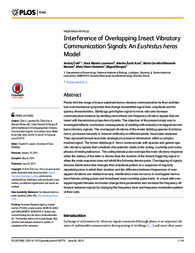Interference of overlapping insect vibratory communication signals: an Eushistus heros Model.
Interference of overlapping insect vibratory communication signals: an Eushistus heros Model.
Author(s): COKL, A.; LAUMANN, R. A.; KOSI, A. Z.; MORAES, M. C. B.; VIRANT-DOBERLET, M.; BORGES, M.
Summary: Plants limit the range of insect substrate-borne vibratory communication by their architecture and mechanical properties that change transmitted signal time, amplitude and frequency characteristics. Stinkbugs gain higher signal-to-noise ratio and increase communication distance by emitting narrowband low frequency vibratory signals that are tuned with transmission properties of plants. The objective of the present study was to investigate hitherto overlooked consequences of duetting with mutually overlapped narrowband vibratory signals. The overlapped vibrations of the model stinkbug species Eushistus heros , produced naturally or induced artificially on different plants, have been analysed. They represent female and male strategies to preserve information within a complex masked signal. The brown stinkbugs E. heros cmmunicate with species and gender spe- cific vibratory signals that constitute characteristic duets in the calling, courtship and rivalry phases of mating behaviour. The calling female pulse overlaps the male vibratory response when the latency of the latter is shorter than the duration of the female triggering signal or when the male response does not inhibit the following female pulse. Overlapping of signals induces interference that changes their amplitude pattern to a sequence of regularly repeated pulses in which their duration and the difference between frequencies of overlapped vibrations are related inversely. Interference does not occur in overlapped narrow band female calling pulses and broadband male courtship pulse trains. In a duet with overlapped signals females and males change time parameters and increase the frequency dif- ference between signals by changing the frequency level and frequency modulation pattern of their calls.
Publication year: 2015
Types of publication: Journal article
Keywords: Communication Signals, Eushistus heros, Inseto, Sinais de comunicação
Observation
Some of Embrapa's publications are published as ePub files. To read them, use or download one of the following free software options to your computer or mobile device. Android: Google Play Books; IOS: iBooks; Windows and Linux: Calibre.
Access other publications
Access the Agricultural Research Database (BDPA) to consult Embrapa's full library collection and records.
Visit Embrapa Bookstore to purchase books and other publications sold by Embrapa.

